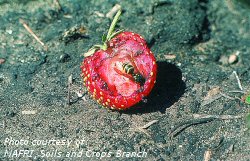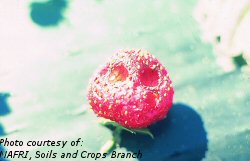Yellowjacket Wasps (Vespula Species)

Yellowjacket wasp on strawberry

Strawberry damage caused by wasp feeding Yellowjacket wasp
Host Plants And Distribution
Wasps do not attack particular plants but are scavengers of a wide variety of food items. They are widely distributed in North America. In Canada, their numbers are generally higher following a milder winter.
Biology
Females overwinter singly to start new colonies in the spring of each year. The queen locates a suitable nesting site and proceeds to build a nest. The nest may be located in a variety of protected areas, including buildings, woodpiles, underground or unprotected areas such as trees and shrubs. As the year progresses, the colony gets larger and wasps become more numerous, with populations peaking in the fall. Adult wasps are yellow and black and reach a length of 15-20 mm. Workers scavenge for insects or rotting fruit to provision the nest and feed the larvae.
Symptoms and Damage
Wasps generally do not damage crops but are a nuisance and potentially dangerous. They often feed on damaged and over-ripe fruit and may be present when the fruit is being harvested. Regular sanitation of the growing area is effective in controlling populations.
Scouting Techniques
Scouting may be difficult due to the variety of areas that the nests may be located in. Large numbers of wasps in one location may indicate the presence of a nest. The area may be inspected using great care.
Economic Thresholds
No thresholds have been established, as these insects are more commonly a nuisance than an economic threat. Removal or destruction of a nest is the most effective treatment but must be carried out with extreme caution. A professional should be consulted before attempting to remove or destroy a nest.
